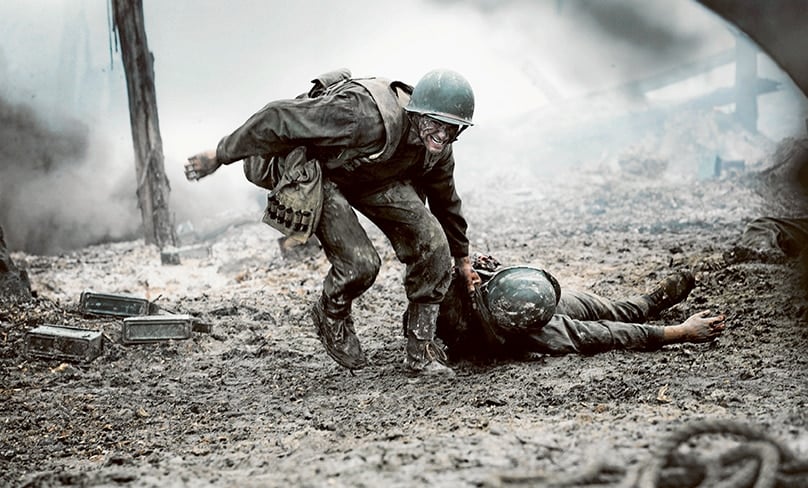
In the 75 years since its conclusion, the Second World War has been the subject of innumerable films of widely varied worth.
Some have focused on the ordeal of combat; others have recounted personal stories set against the background of the global conflict.
Following, in alphabetical order, are capsule reviews of 15 of these movies.
They have been chosen both for artistic quality and for their educational value in conveying, whether through fact-based plots or at least plausible ones, what the experience of living through the struggle was like for those who did so.
Battle of Britain (1969)
With the fall of France in 1940, Great Britain stood alone against the might of the German air force. The movie pays tribute to the smaller number of British fighter pilots who, in the months that followed, downed so many planes that the Luftwaffe was unable to mount its massive raids. Laurence Olivier, Michael Redgrave and Trevor Howard star in this huge and impressive British production directed by Guy Hamilton. Wartime violence. A-I – general patronage.
Hacksaw Ridge (2016)
The extraordinary heroism of Army medic Desmond Doss (Andrew Garfield) during the Battle of Okinawa is vividly realised in this fact-based drama, directed by Mel Gibson. A committed Christian and conscientious objector who refused to bear arms, Doss was nonetheless eager to serve his country, despite the misgivings of his parents (Hugo Weaving and Rachel Griffiths) and his fiancée (Teresa Palmer). Doss overcomes the ridicule and abuse of his fellow recruits in boot camp as well as an effort to discharge him led by the sergeant (Vince Vaughn) heading his platoon and the captain (Sam Worthington) commanding his company. Once in combat, he single-handedly saves the lives of over 75 wounded soldiers while under constant enemy fire. Graphic war violence with much gore, brief rear male nudity, a scene of marital sensuality, considerable crude language. L – limited adult audience, films whose problematic content many adults would find troubling.
A Bridge Too Far (1977)
Director Richard Attenborough’s large-scale re-creation of the tragic Allied offensive code-named Market Garden details the fate of the massive paratroop force dropped behind German lines in Holland. The excellent all-star cast includes Dirk Bogarde, Anthony Hopkins, Laurence Olivier, Robert Redford, Ryan O’Neal, Gene Hackman and Elliot Gould. Although the violence is unusually graphic, the movie has value as an historical dramatisation that has tried to be faithful to the facts. A-III – adults.
The Dam Busters (1954)
Engrossing story of how the German steel mills in the Ruhr valley were flooded by British bombers (led by Richard Todd) using an ingenious bouncing bomb designed by a scientist (Michael Redgrave) to penetrate the area’s fortified dams. Directed by Michael Anderson from R.C. Sheriff’s script, the well-paced narrative details the bomb’s invention, the training of the bomber crews and the dangers of the mission. A-I – general patronage.
The Great Escape (1963)
Thrilling rendition of a fact-based story about an elaborate escape of Allied prisoners from a German POW camp. Steve McQueen is the most ambitious of a crew that includes James Garner, Charles Bronson, James Coburn and Richard Attenborough as they plot a mass escape which becomes an intriguing, highly entertaining suspense gripper. With John Sturges directing, it all builds to a stunning, sobering climax that both tugs at the heart and keeps it racing. A-I – general patronage.
Hope and Glory (1987)
Fine British dramatisation about a young boy growing up amid the terror and excitement of the London blitz. Director John Boorman’s fact-based re-creation eloquently expresses a child’s sense of wonder and hopefulness in contrast to the anxiety-ridden, pessimistic and socially conscious lives of the adults around him. Seriocomic treatment of several restrained sexual scenes and some rough language. A-III – adults.
The Longest Day (1962)
The Allied invasion of Normandy on 6 June 1944, is re-created on an epic scale in this three-hour dramatisation of the operational preparations, behind-the-line activities but mostly the ferocious battle itself, with particular attention to the American landings at Omaha Beach. Directed by Ken Annakin, Andrew Marton and Bernhard Wicki, the result is an absorbing account of D-Day from both sides of the battlefield, with convincing portrayals of men in combat from an international cast headed by John Wayne, Robert Mitchum and Henry Fonda. Wartime violence seen in the context of a righteous cause. A-I – general patronage.
Saving Private Ryan (1998)
Riveting war drama set during and immediately after D-Day 1944 when seven soldiers, led by their captain (Tom Hanks), are ordered to go behind German enemy lines to rescue a GI (Matt Damon) whose three brothers had been killed in action the previous week. Director Steven Spielberg brilliantly re-creates the horror and chaos of warfare, never losing sight of the soldiers’ humanity, savagery and patriotism even as they question the justification of their mission. Graphic battlefield violence with gore, some profanity and recurring rough language. A-III – adults.
The Thin Red Line (1998)
Eloquent meditation on the insanity of warfare takes place as American soldiers (notably Sean Penn, Ben Chaplin, Nick Nolte and Jim Caviezel) battle the Japanese forces entrenched on Guadalcanal while reflecting on what brought each to this once-peaceful tropical paradise. Based on the James Jones novel, director Terrence Malick’s lengthy philosophical drama views war as a desecration to all living things — be they human, animal or vegetable. Graphic battlefield violence, fleeting nudity and recurring rough language and profanity. A-III – adults.
